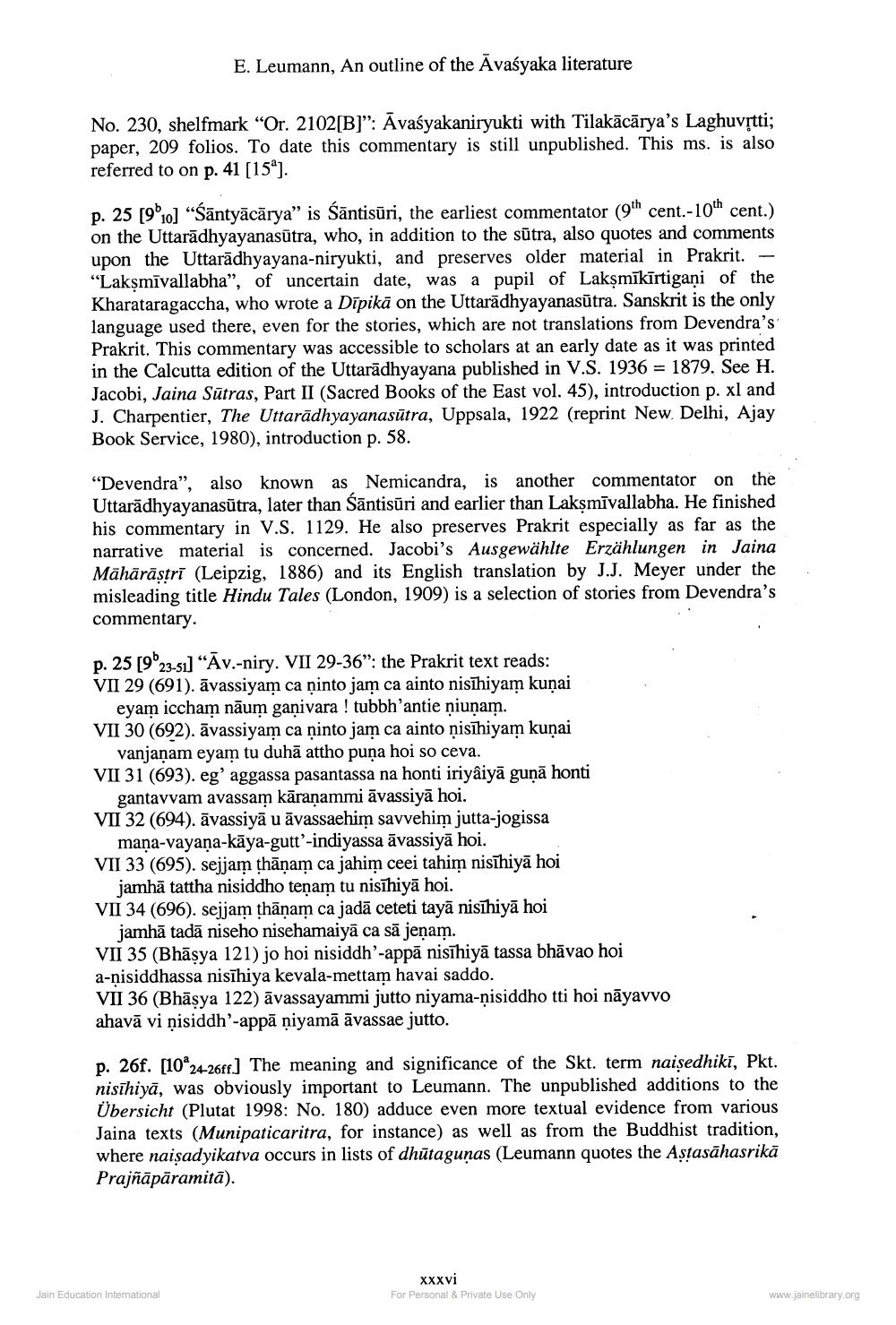________________
E. Leumann, An outline of the Avaśyaka literature
No. 230, shelfmark "Or. 2102[B]": Āvasyakaniryukti with Tilakācārya's Laghuvịtti; paper, 209 folios. To date this commentary is still unpublished. This ms, is also referred to on p. 41 [154].
p. 25 (9'10] "śāntyācārya" is śāntisūri, the earliest commentator (9th cent.-10th cent.) on the Uttarādhyayanasūtra, who, in addition to the sūtra, also quotes and comments upon the Uttarādhyayana-niryukti, and preserves older material in Prakrit. - “Lakşmīvallabha”, of uncertain date, was a pupil of Laksmīkīrtigani of the Kharataragaccha, who wrote a Dīpikā on the Uttarādhyayanasūtra. Sanskrit is the only language used there, even for the stories, which are not translations from Devendra's Prakrit. This commentary was accessible to scholars at an early date as it was printed in the Calcutta edition of the Uttarādhyayana published in V.S. 1936 = 1879. See H. Jacobi, Jaina Sūtras, Part II (Sacred Books of the East vol. 45), introduction p. xl and J. Charpentier, The Uttarādhyayanasūtra, Uppsala, 1922 (reprint New Delhi, Ajay Book Service, 1980), introduction p. 58.
“Devendra", also known as Nemicandra, is another commentator on the Uttarādhyayanasūtra, later than Śāntisūri and earlier than Laksmīvallabha. He finished his commentary in V.S. 1129. He also preserves Prakrit especially as far as the narrative material is concerned. Jacobi's Ausgewählte Erzählungen in Jaina Māhārāstrī (Leipzig, 1886) and its English translation by J.J. Meyer under the misleading title Hindu Tales (London, 1909) is a selection of stories from Devendra's commentary.
p. 25 [923-su] "Āv.-niry. VII 29-36": the Prakrit text reads: VII 29 (691). āvassiyam ca ņinto jam ca ainto nisīhiyam kuņai
eyam iccham nāum ganivara ! tubbh'antie niunam. VII 30 (692). āvassiyam ca ninto jam ca ainto nisīhiyam kunai
vanjanam eyam tu duhā attho puņa hoi so ceva. VII 31 (693). eg' aggassa pasantassa na honti iriyâiyā guņā honti
gantavvam avassam kāranammi āvassiyā hoi. VII 32 (694). āvassiyā u āvassaehim savvehim jutta-jogissa
mana-vayaņa-kāya-gutt-indiyassa āvassiyā hoi. VII 33 (695). sejjam thānam ca jahim ceei tahim nisīhiyā hoi
jamhā tattha nisiddho tenam tu nisīhiyā hoi. VII 34 (696). sejjam thāṇam ca jadā ceteti tayā nisīhiyā hoi
jamhā tadā niseho nisehamaiyā ca sā jeņam. VII 35 (Bhāsya 121) jo hoi nisiddh'-appā nisīhiyā tassa bhāvao hoi a-nisiddhassa nisīhiya kevala-mettam havai saddo. VII 36 (Bhāsya 122)āvassayammi jutto niyama-nisiddho tti hoi nāyavvo ahavā vi ņisiddh'-appā niyamā āvassae jutto.
p. 26f. [1024-26ff.] The meaning and significance of the Skt. term naisedhiki, Pkt. nisīhiyā, was obviously important to Leumann. The unpublished additions to the Übersicht (Plutat 1998: No. 180) adduce even more textual evidence from various Jaina texts (Munipaticaritra, for instance) as well as from the Buddhist tradition, where naisadyikatva occurs in lists of dhūtagunas (Leumann quotes the Astasāhasrikā Prajnapāramita).
Jain Education International
XXXVI For Personal & Private Use Only
www.jainelibrary.org




